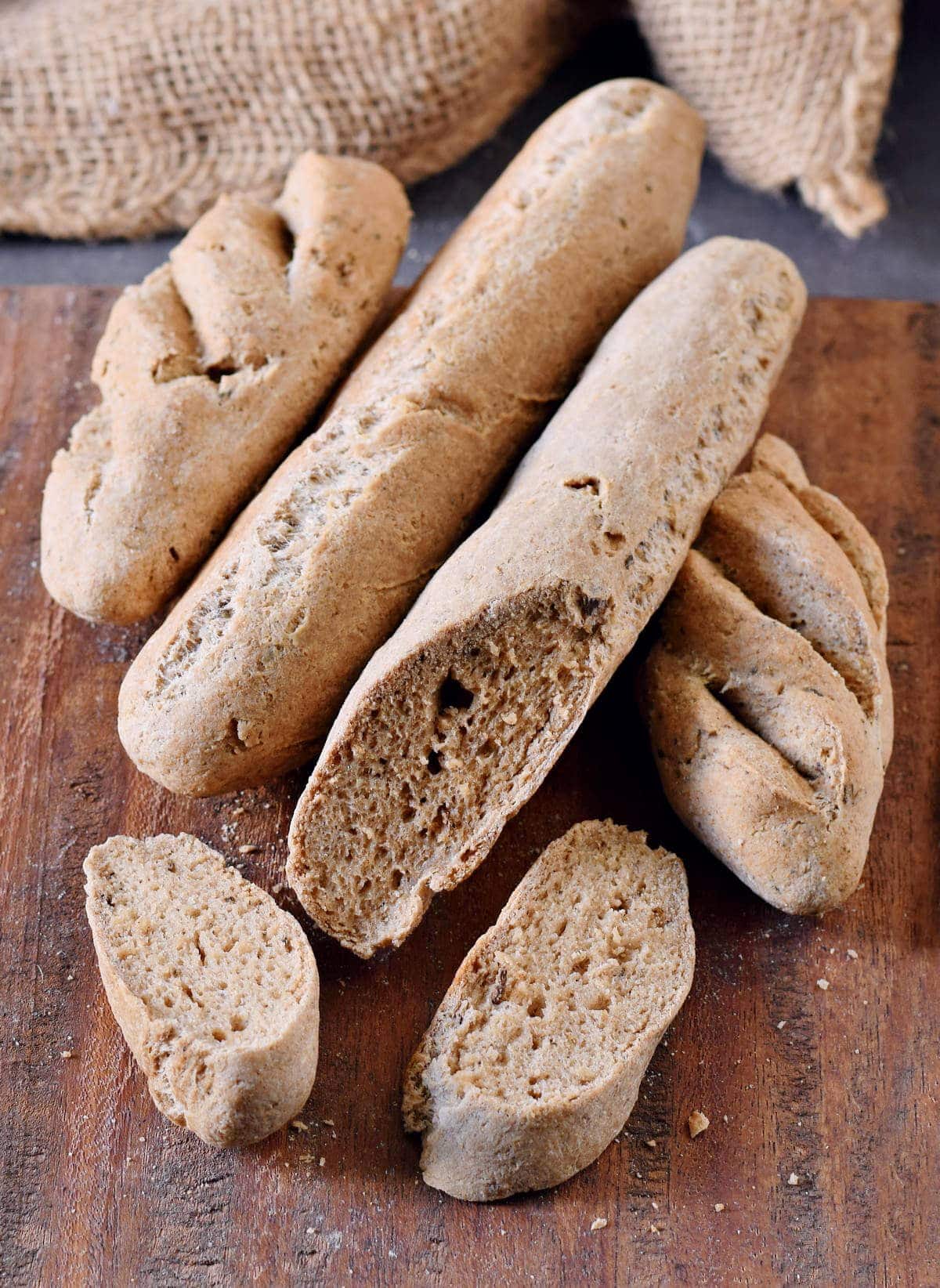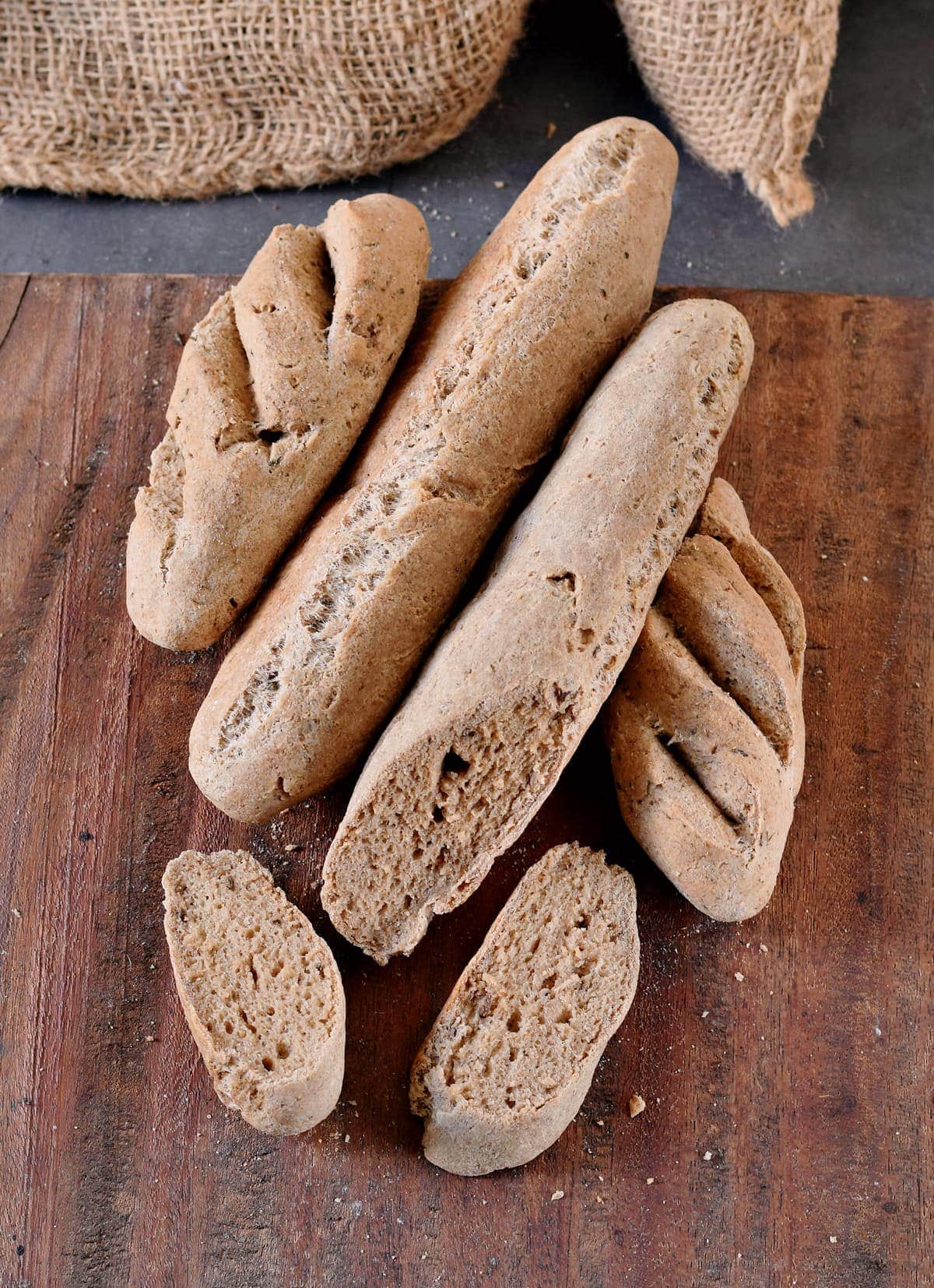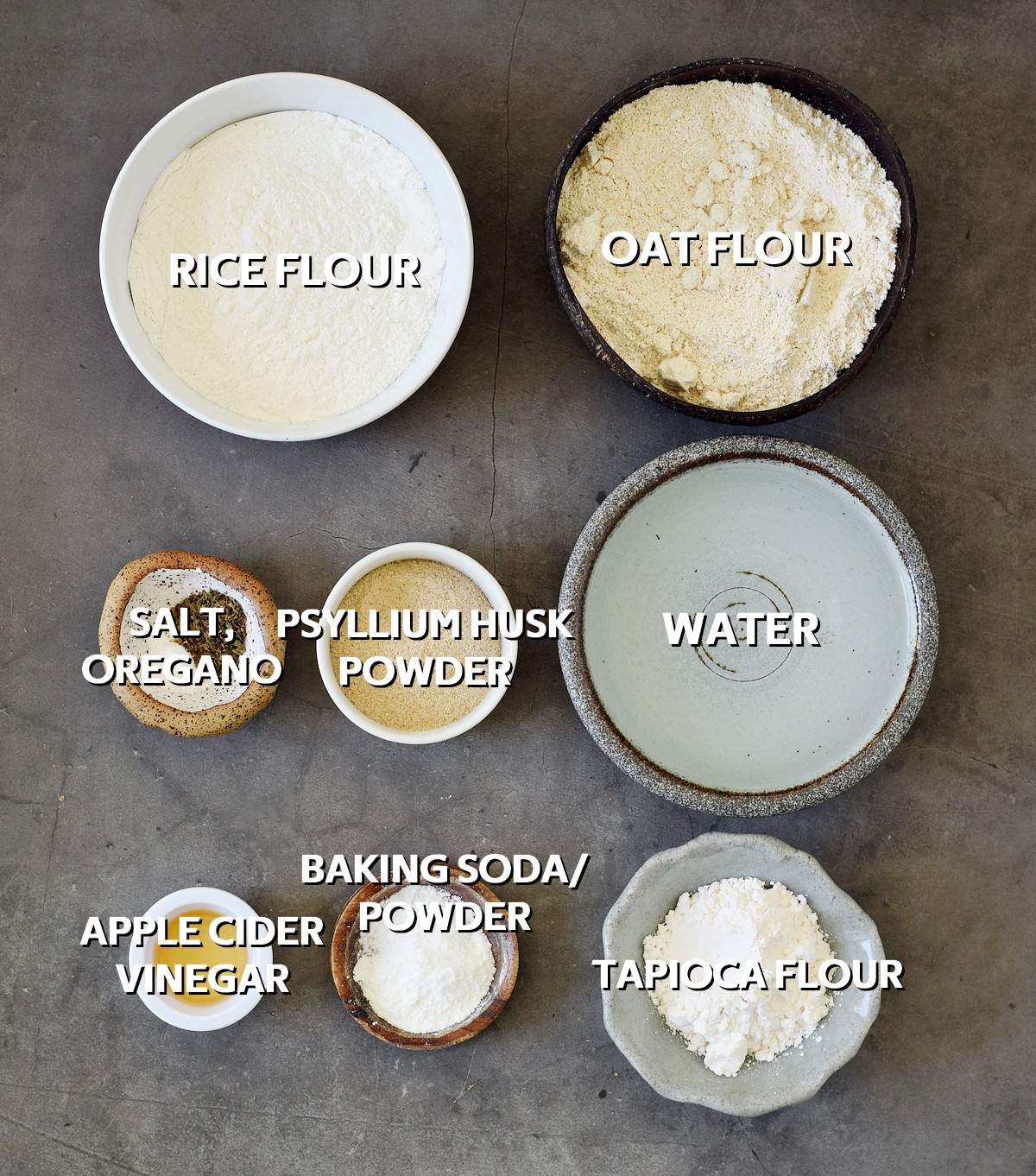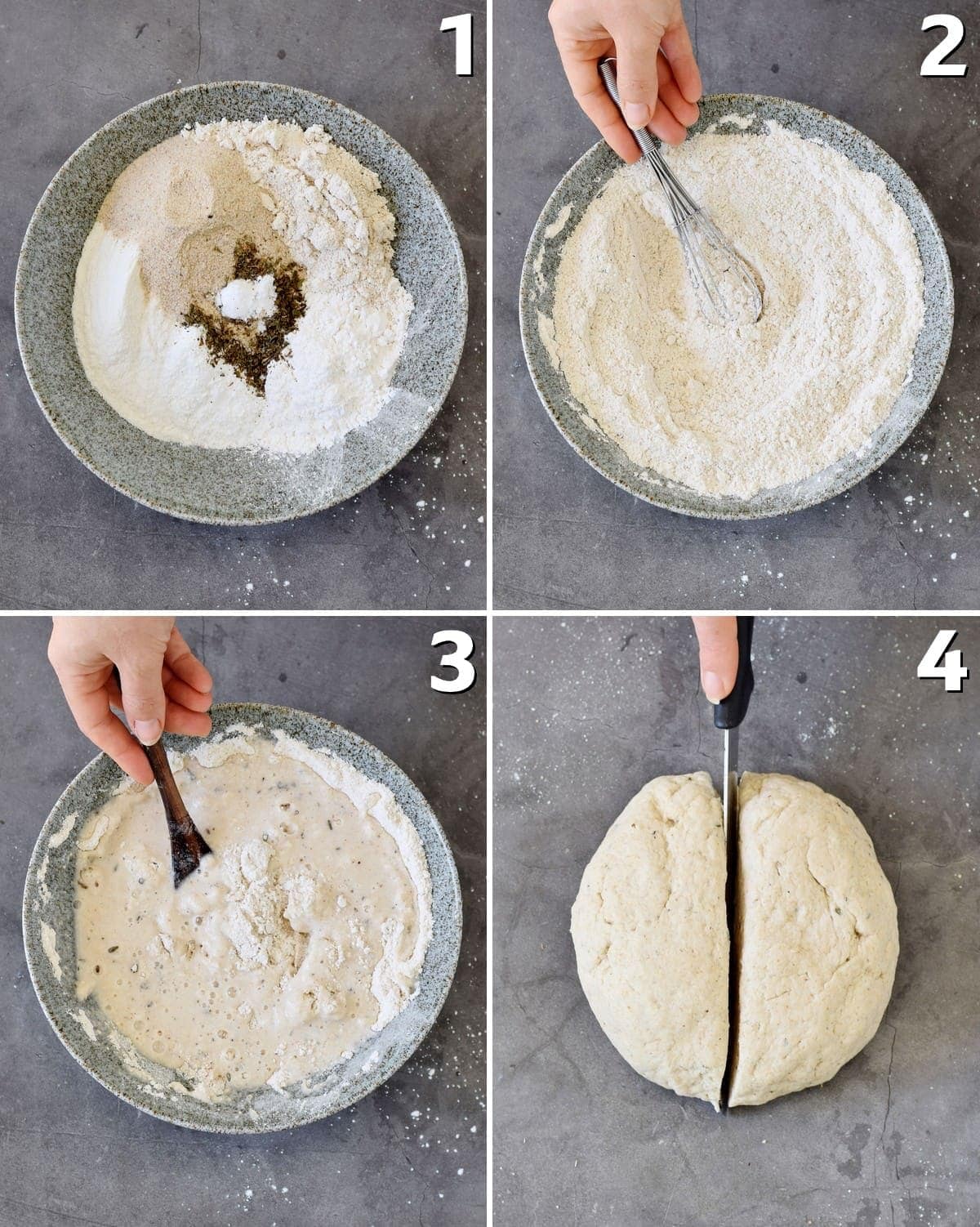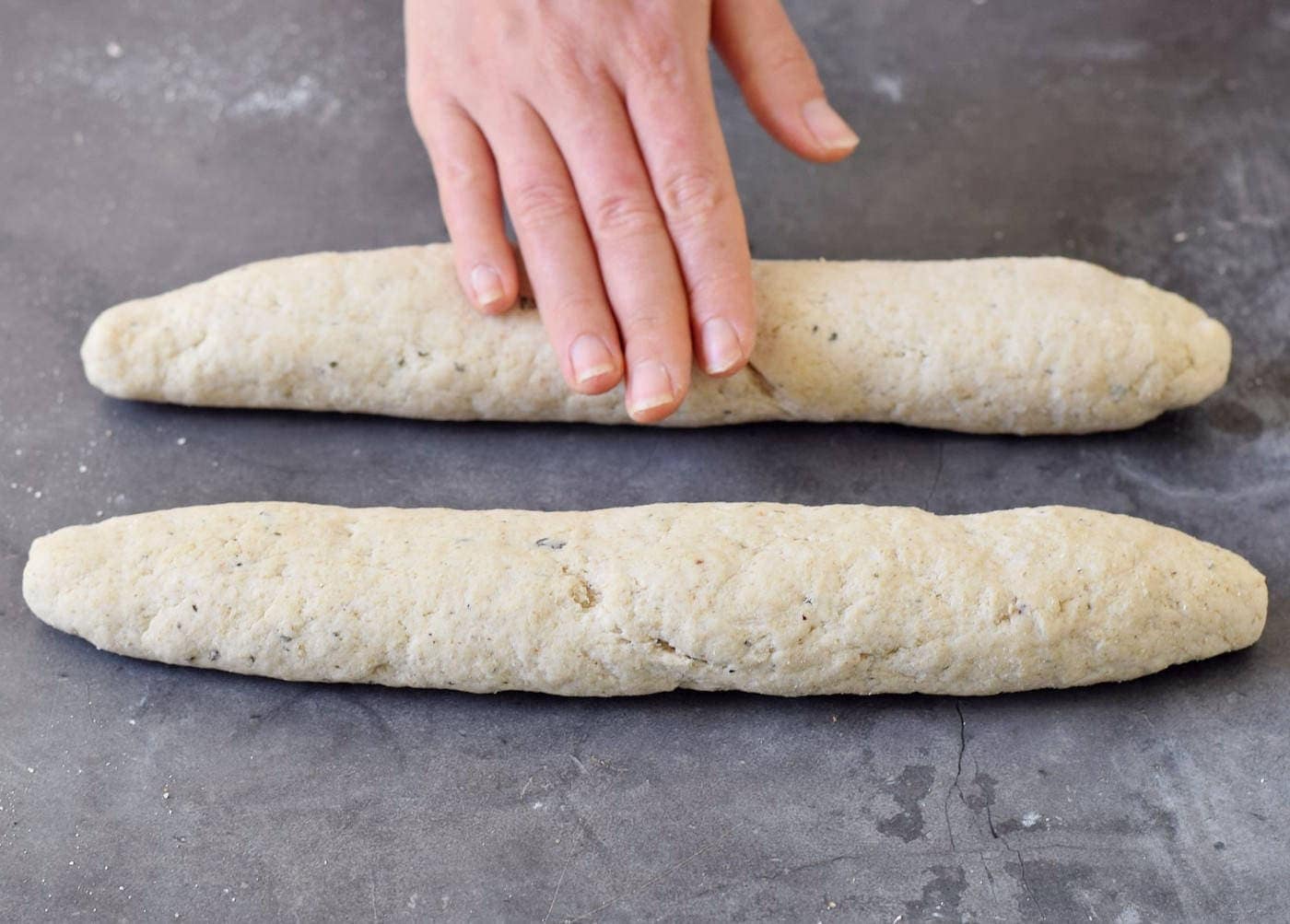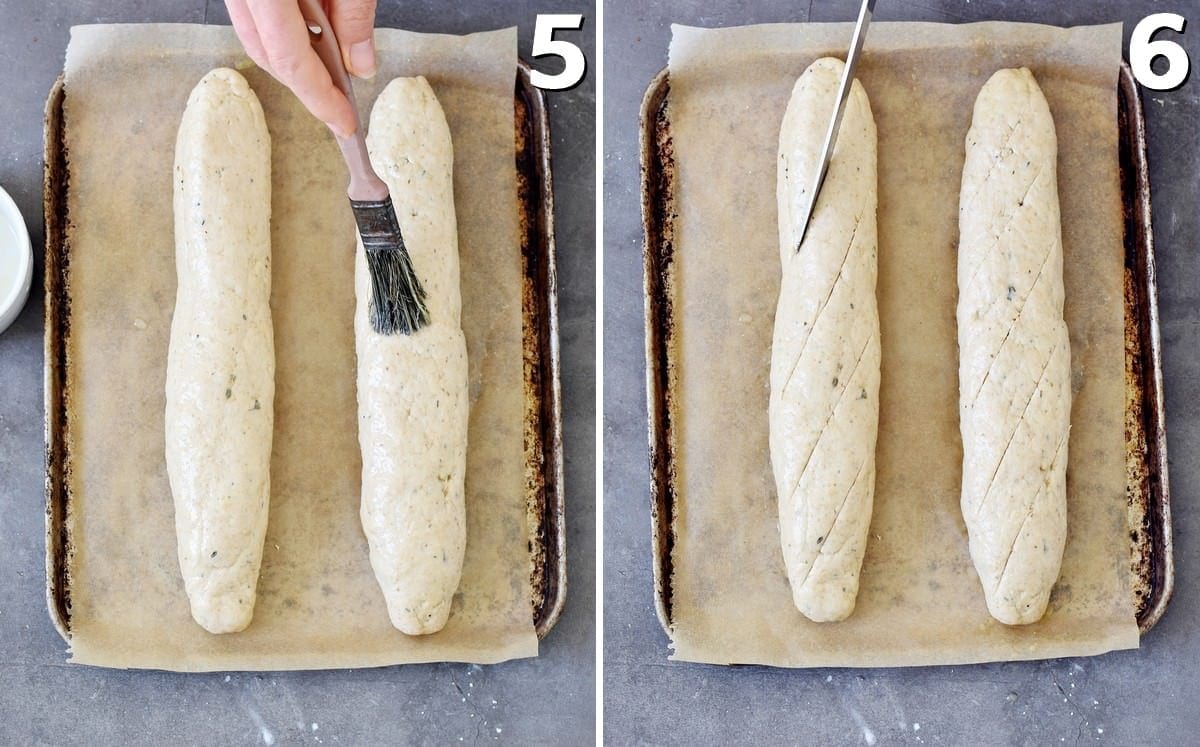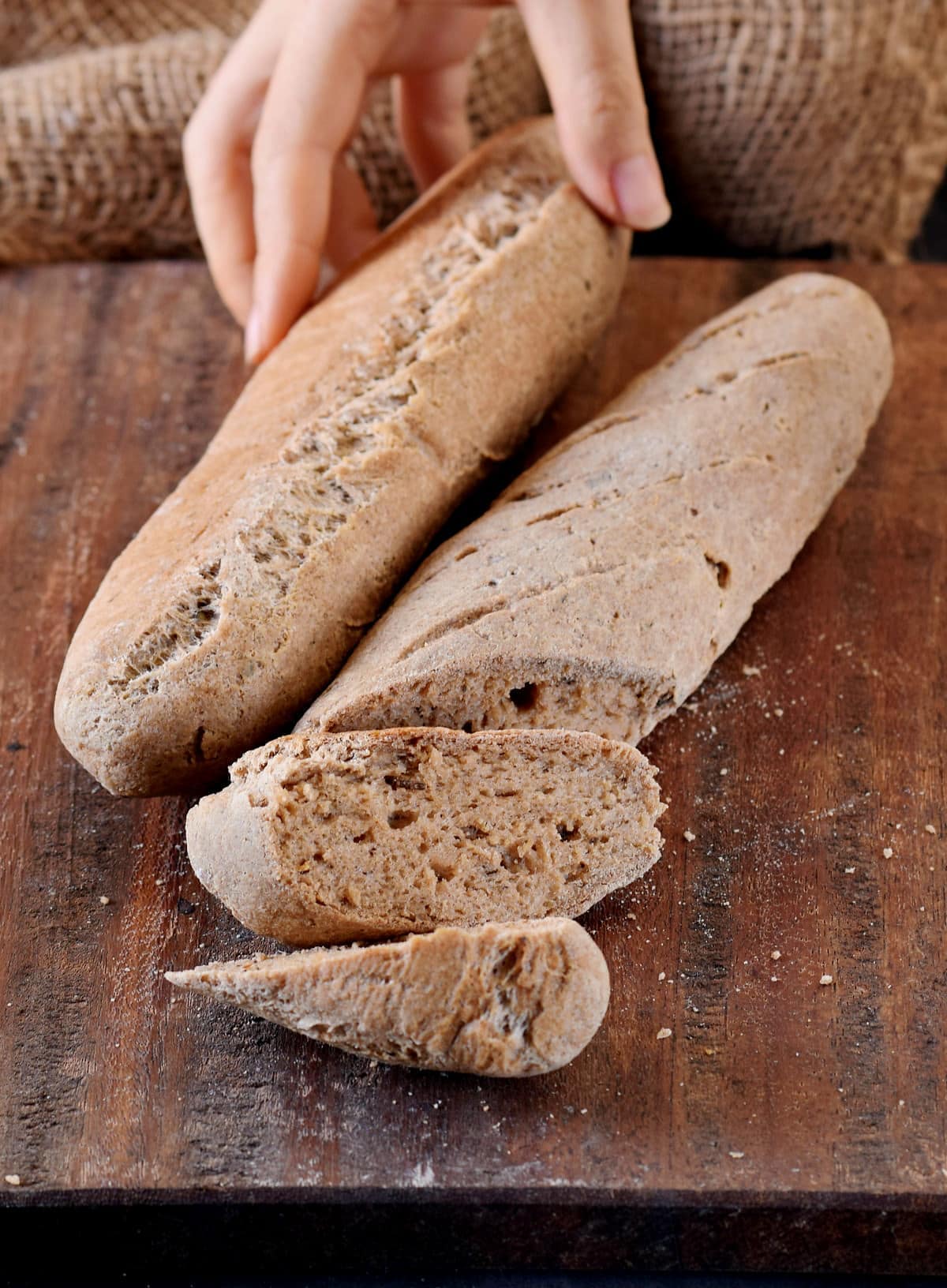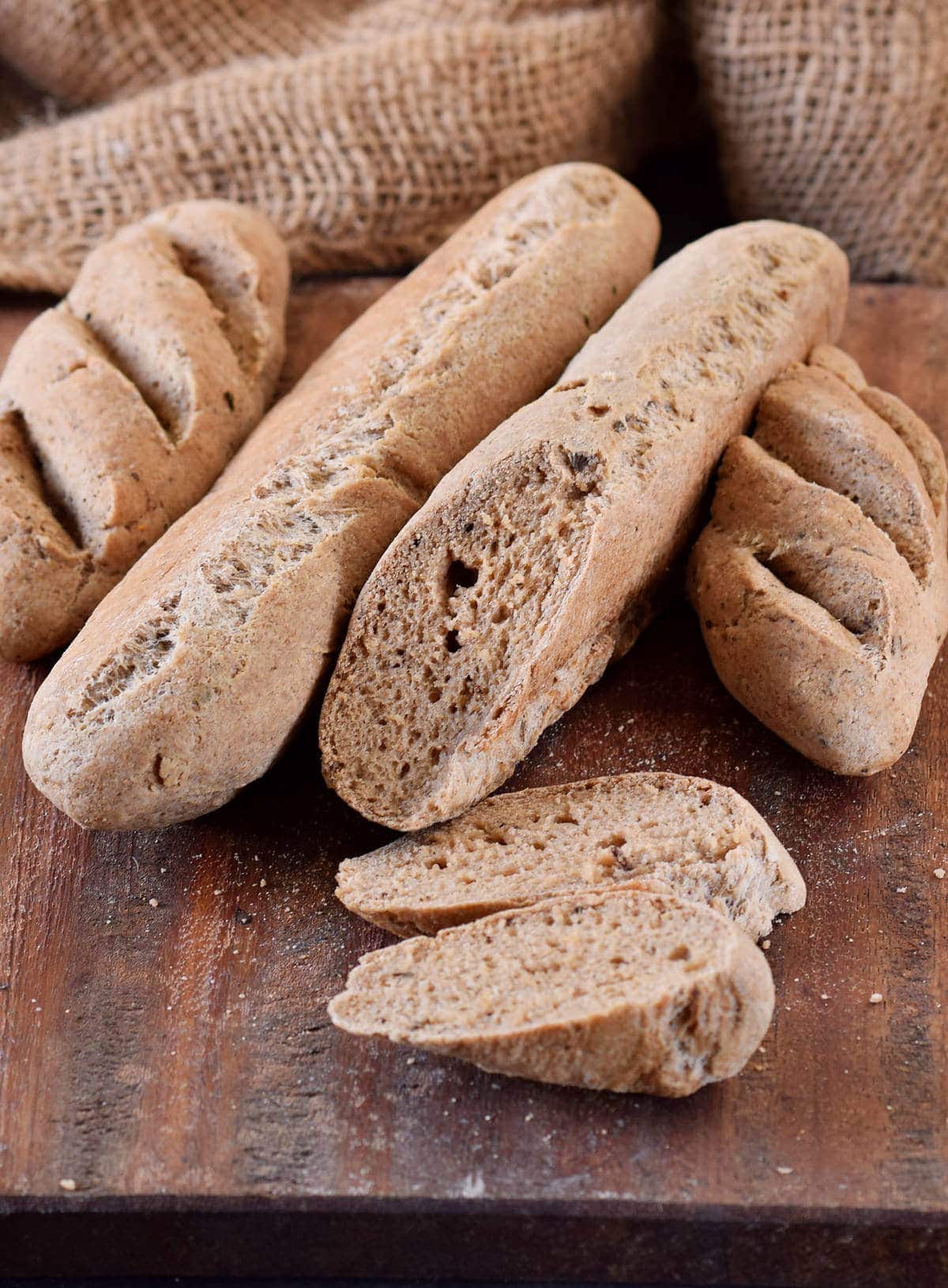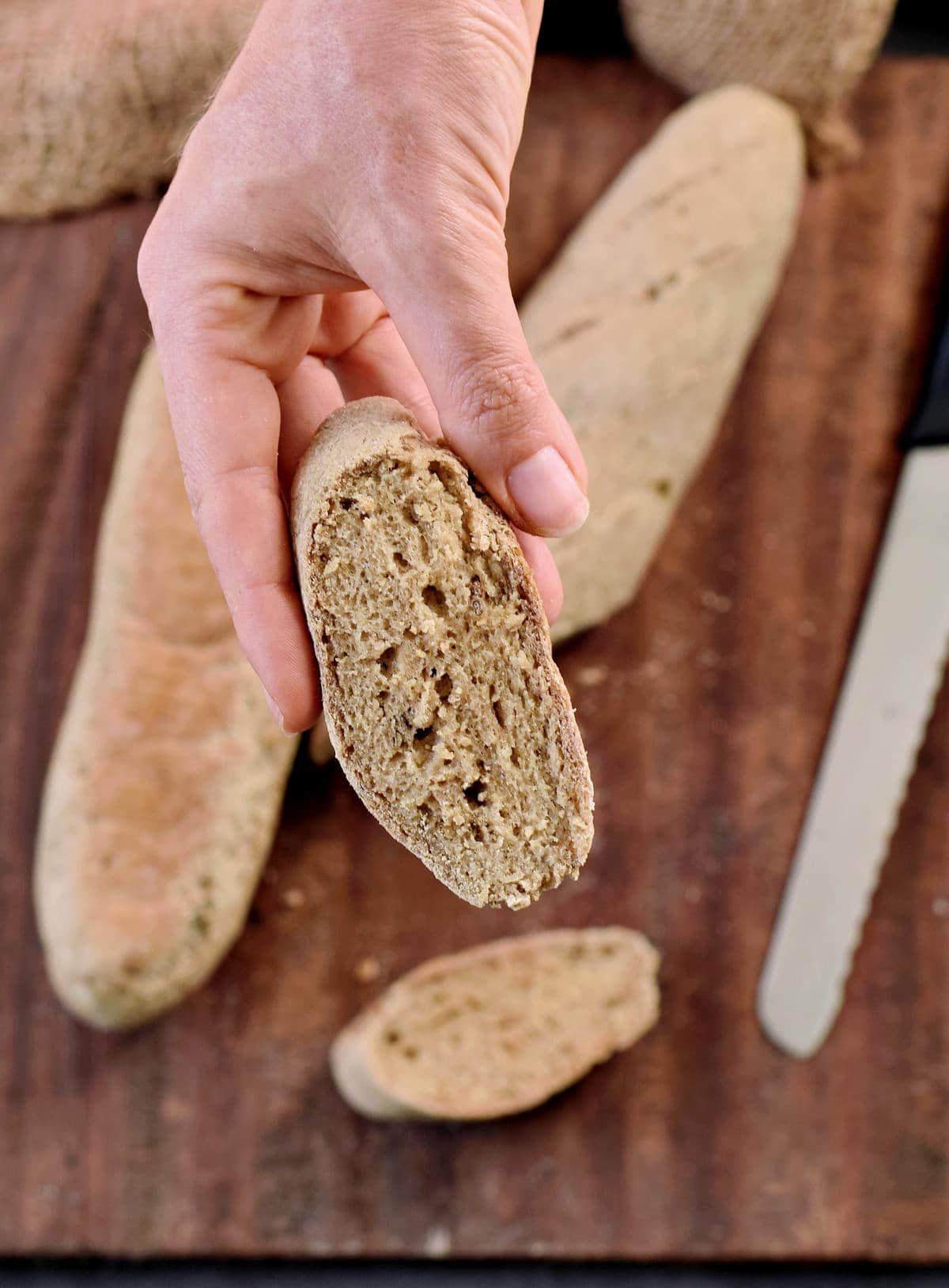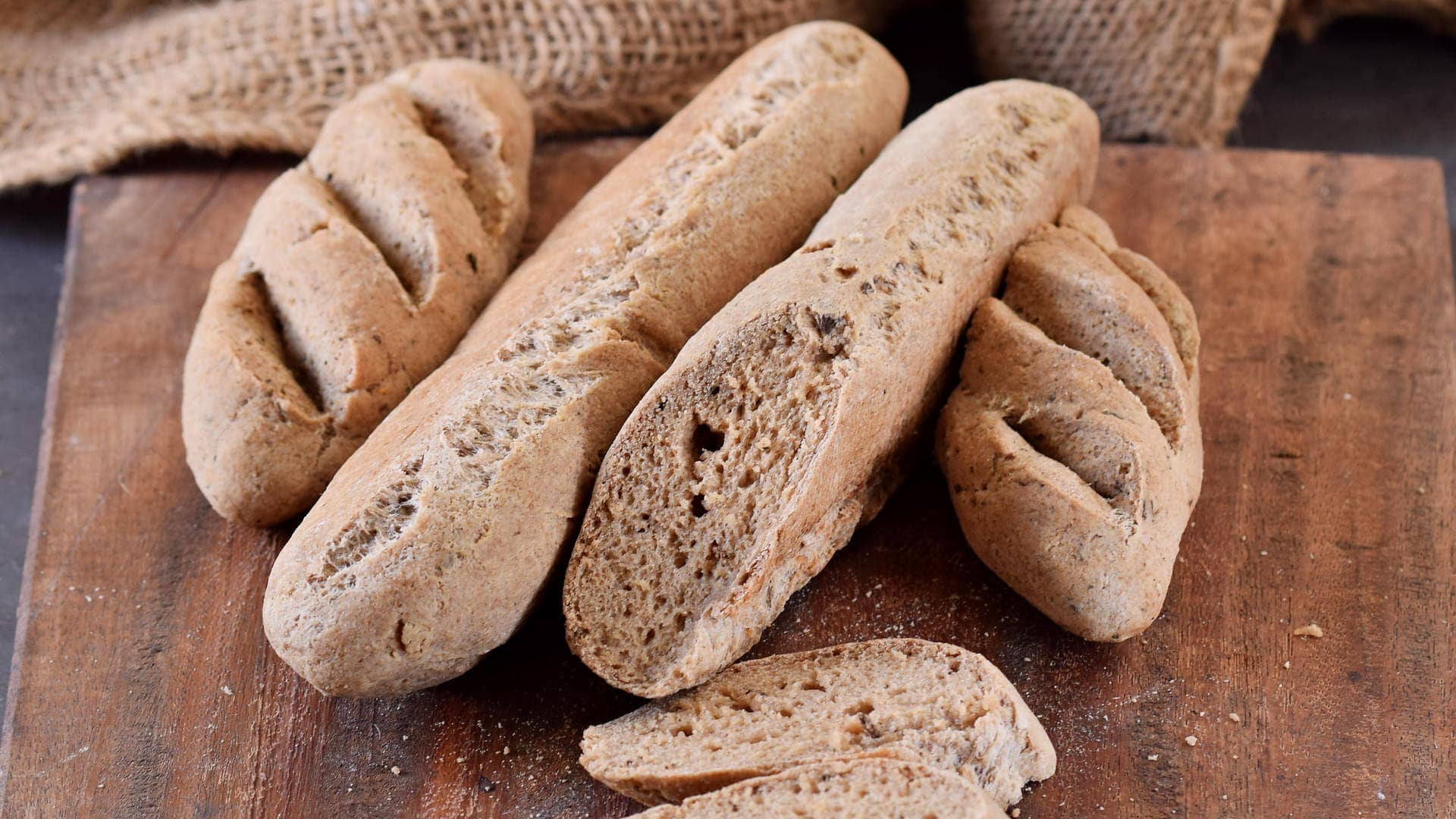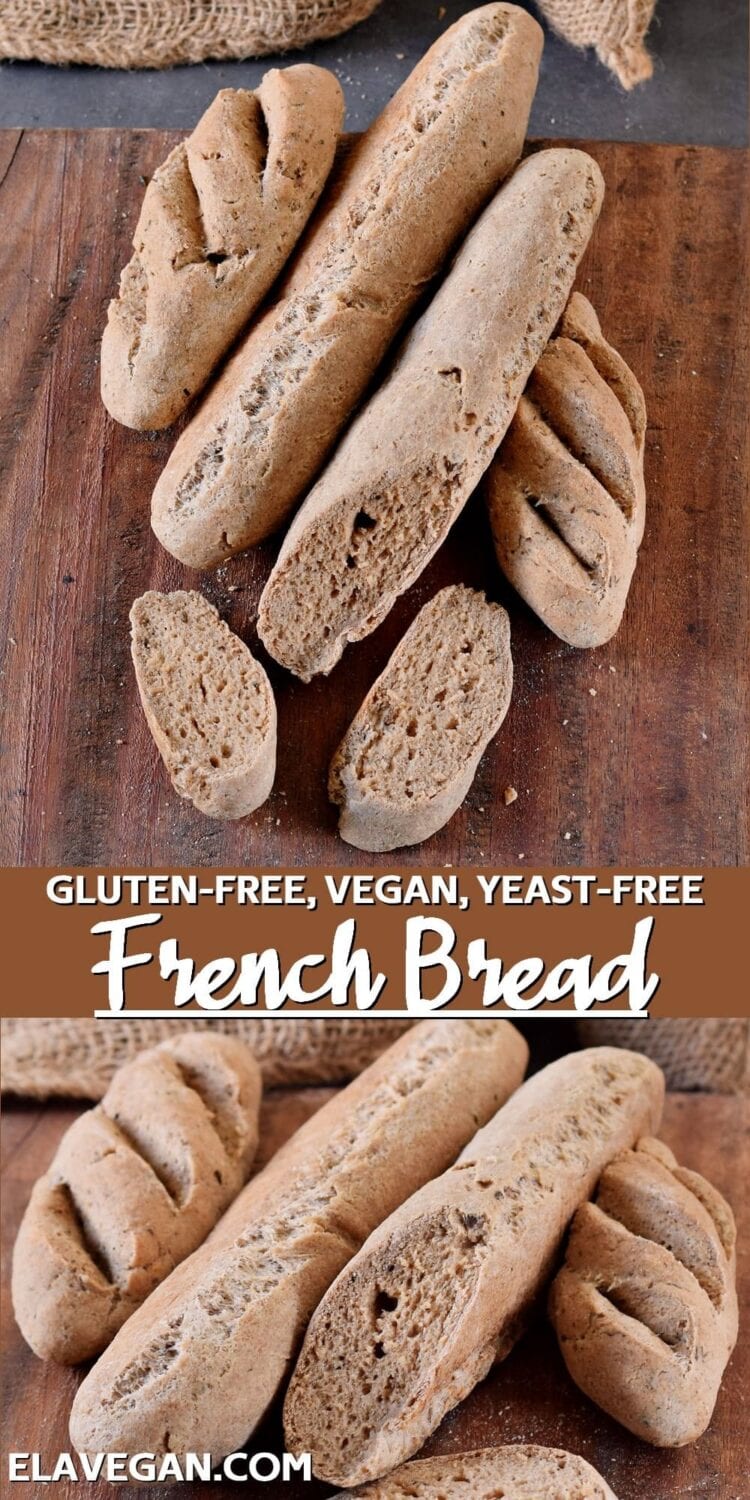I spent Winter filling my house with the warming scent of sweet treats baking in the oven – like this vegan streusel apple pie and double choc chip fudge cookies. However, if you were to ask me what smell could rival that of freshly baking desserts, it would have to be bread! While this gluten-free French bread may not smell exactly the same as its yeast-containing counterparts, it’s still just as satisfying- especially served warm. After spending weeks perfecting my crusty gluten-free loaf in 2019, I turned my hand towards trying to perfect other favorites of mine. I think you can guess the top of my list- gluten-free baguette! I wanted this vegan bread to be soft inside, rounded in shape, with a thin crusty exterior- mission successful. While I’ve enjoyed sharing some of my favorite flatbread recipes recently, like this naan and pita bread, when you want something crusty and bread-like, those just won’t cut it. Instead, this gluten-free baguette recipe is for you!
Simple No Yeast Bread
Not only is this a super simple bread recipe (tried and tested countless times to get the texture just right!), but as it’s for bread without yeast, it requires no rising time which means the loaves can be shaped immediately and baked to warm, fragrant perfection in under an hour! Once in the oven, the bread will rise nicely – but don’t expect it to be 100 % as light and fluffy as a French baguette made with gluten and yeast. The results are certainly good enough for me, though!
Ingredients For Gluten-Free Baguette
This simple bread recipe requires just 8 ingredients (not including the water):
Flour: I used a combination of white rice flour, oat flour, and tapioca flour (tapioca starch). I’ve tried with several gluten-free flour blends, but this has provided great results. Psyllium husk powder: If you have whole psyllium husk, then use a blender or electric coffee/spice grinder for a few seconds into a powder. Please do NOT leave out or sub this ingredient. Leavening Agents: Baking powder & Baking soda will provide lift in this gluten-free French bread (without yeast needed). Spices: Salt for seasoning, oregano (optional) Apple Cider Vinegar: It’s best to use unfiltered, unpasteurized apple cider vinegar. This helps to strengthen the gluten-free dough and provide a springy texture. You can use regular vinegar instead. Water
For the full ingredients list, measurements, complete recipe method, and nutritional information, read the recipe card below.
How To Make Gluten-Free French Bread
I recommend measuring the ingredients on a kitchen scale in grams (use my written measurements) for exact results.
Step 1: Prepare the French baguette dough
Preheat the oven to 380°F/195 °C and line a baking sheet with parchment paper. In a large bowl, combine all the dry ingredients, sifting the baking powder and soda if they’re clumpy. Then add the water and vinegar to the bowl. Mix it into a rough dough with a spoon. Then use your hands to knead the dough for a few minutes. The dough will seem too wet, to begin with, but once the psyllium soaks up the water, it will become nice and pliable.
The dough should be slightly sticky, not too dry, but also not too wet. Add a little tapioca flour if it’s too sticky or a little water if it’s too dry. This can depend on how fine your flour is (some brands are finer than others) and your climate (if it’s humid or dry).
Step 2: Shape the dough
Divide the dough into two equal parts and shape each into a long baguette loaf shape (refer to next photo). Place them on a lined baking sheet and brush each loaf with a mixture of water, oil, and baking soda. Make 4-5 elongated angled slits down each one with a knife (this no yeast bread requires no rising time!).
Step 3: Bake it
Bake the gluten-free French bread loaves in the oven for about 50-60 minutes. Allow them to cool, and then slice and enjoy.
How To Store?
Like traditional French baguettes, this gluten-free baguette is best when eaten within 1-2 days of baking. If you plan to store it for longer, then freezing is the best option. You can freeze the baguette whole or pre-sliced (so it’s easy to remove precisely how much you need in one go) for up to 3 months, tightly wrapped in two layers of plastic wrap. If you pre-slice the bread, then place bits of wax paper/parchment paper between each slice, so they don’t stick together as it freezes. Thaw in the fridge before using or reheat from frozen.
How To Serve
You can enjoy this gluten-free French bread any way that you usually would.
Serve the vegan bread warm and slathered in dairy-free butter. Served alongside soup – like this Creamy Carrot Ginger Soup or Vegan Corn Chowder Or even to top the soup – like this Vegan French Onion Soup. Mop up stew sauce – like this Easy Veggie Stew or Vegan Hungarian Goulash As part of charcuterie board/ cheese platter – with Vegan Cheese. To dip into Vegan Cheese Fondue. Use it to make baguette sandwiches. Use with dips – like Oil-Free Hummus, Vegan French Onion Dip, or Easy Vegan Spinach Artichoke Dip. Create into pizza slices, topped with a little marinara, Vegan Cheese Sauce, topping/s of your choice, then broiled for a few minutes. Serve as an appetizer bruschetta, brushed with a little olive oil and topped with plenty of freshly chopped tomatoes, garlic, and herbs.
Really, the sky is the limit!
Why use psyllium husk in this gluten-free bread recipe?
Psyllium husk is combined with water to create a gel-like consistency (similar to flax/chia eggs), acting as a gluten-replacement to create a bread-like dough rather than something sad and crumbly. It is also key to getting the bread-like chewy consistency we all want in our GF bakes. Note that different psyllium husk brands react differently, so if you’re new to the ingredient – this may require a little experimentation. Some brands can even turn your baked goods purple! (it’s all-natural, but a bit odd).
How to reheat French bread?
This gluten-free French bread is fairly versatile and can be toasted and broiled (grilled) depending on what you want it for. If the loaf is starting to get a little harder, however, then sprinkle it with a little water. Then wrap it in foil (it also works without foil) and heat in the oven until warmed and lightly springy when pressed on the top. This will breathe life back into it.
Recipe Notes & Variations
You could use a stand mixer with a dough hook for the kneading part of this baguette recipe. Feel free to change the size of the gluten-free baguettes. Make several smaller ones instead of two larger, etc. Just note that the baking time will vary. If you want to create even more of a crusty loaf, it’s good to create a little steam in the oven at the beginning of the baking process. To do this, you could add a few ice-cubes to an oven-safe bowl/plate on the floor of the oven or lightly spritz/brush the loaves with a mixture of water, baking soda, and a little oil right before placing them in the oven (that’s what I did). You can purchase special perforated French bread pans, which circulate the air around the entire loaf for even crustier results too. However, it’s definitely not necessary for this recipe.
Other Gluten-Free Bread Recipes
Gluten-Free Pita Bread Gluten-Free Naan (Indian Flatbread) Keto Tortillas with Almond Flour Simple Gluten-Free Tortillas Gluten-Free Buns (Bread Rolls) Gluten-Free Vegan Bread
If you give this gluten-free French bread recipe a try, I’d love a comment and ★★★★★ recipe rating below. Also, please don’t forget to tag me in re-creations on Instagram or Facebook with @elavegan and #elavegan – I love seeing them.
